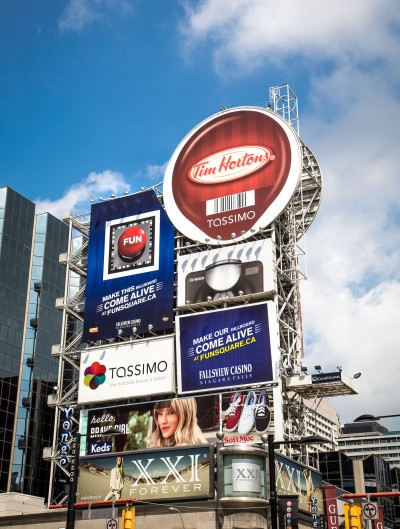Future directions
Based on findings from the new study, a consultant retained by Toronto’s sign bylaw unit has proposed the following policy directions:
General requirements
- Reduce maximum illumination levels to 300 nits from sunset to sunrise and 3,000 nits from sunrise to sunset.
- Reduce the maximum level of light trespass from 6.5 lux above ambient light levels to 3 lux when measured from a distance of 10 m (32.8 ft).
Illuminated signs in residential districts
- Continue to permit illuminated signs in residential districts only for institutional uses, such as schools and churches.
- Reduce period of illumination in residential districts to 7 a.m. to 9 p.m., while maintaining current hours of 7 a.m. to 11 p.m. in other sign districts.
Readograph signs
- Permit readograph sign copy for institutional uses in residential districts, subject to: minimum message duration of 60 minutes; maximum transition of one second; no visible transition effects, such as motion, fading or flashing; and the aforementioned reduced hours of illumination.
- Maintain readograph sign copy rules for all other sign districts.

Several years ago, Toronto’s Yonge-Dundas Square was designated a ‘special sign district,’ as it is known for particularly large and bright signage. File photo
Static digital signs
- Permit third-party static digital signs in commercial and ‘employment’ districts, subject to: minimum 60-m (197-ft) setbacks from intersections and residential or residential/commercial districts; minimum 150-m (492-ft) setbacks from other third-party non-digital signs; minimum 500-m (1,640-ft) setbacks from other third-party digital signs; and the application of all other current regulations for these types of signs.
- For first-party signs, allow up to 30 per cent of a wall sign and 50 per cent of a ground sign to consist of digital static copy in commercial and employment districts, with minimum 60-m (197-ft) setbacks from intersections and residential or residential/commercial districts and minimum 300-m (984-ft) distances from other signs displaying digital static copy. These would be subject to a minimum message duration of 60 minutes, maximum one-second transitions and no visible transition effects (e.g. motion, fading, flashing).
Moving digital signs
- Maintain current provisions for signs displaying dynamic digital copy, with approval only by sign variance or bylaw amendment.
Projected digital signage
- Maintain current provisions for projected images, with approval only by sign variance or bylaw amendment.
- Allow temporary approvals for special events through Toronto’s economic development, culture and tourism office.
The next steps will be to review information from public and stakeholder consultations, review applicable regulations and prepare a set of final recommendations for city council. Data and comments from consultations will be collated and legal issues will be analyzed.
One of the challenges is Toronto has a lot of mixed-use space, where the lines between residential and commercial districts are blurring, and there is a lot of planned residential use of what were previously industrial or commercial parts of the city. Broader consultation will help make any new bylaw more legally defensible.
Overall, there is more comfort with digital signage today than during the last bylaw review in 2008 and 2009. Back then, many people were afraid there would be giant TVs, but those fears have not come to pass—and ‘giant TV’ has not generally been the industry’s business model anyway.
With files from Ted Van Vliet, manager of Toronto’s sign bylaw unit, who presented a seminar about Toronto’s EMC-related regulations at the Sign Association of Canada’s (SAC’s) 2013 CONSAC trade show and conference. For more information, contact him via e-mail at tvanvli@toronto.ca.





